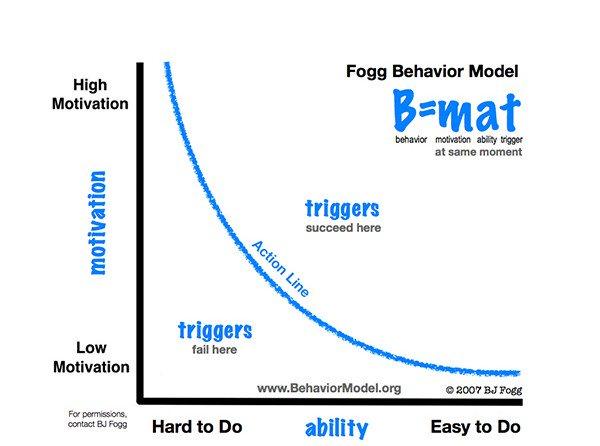
In the projects we work on here at Blink, our clients have specific actions that they would like their users to take on their website or app. For example, one goal might be for a user to download software from a website, while another might be to complete a registration form. In talking to research participants, we often attempt to understand how easy it is for users to go down these happy paths, and understand why users may or may not go down them.

BJ Fogg’s three-part model provides an illuminating lens for thinking about these situations where the goal is to drive user behavior.
The model articulates three components that must be in place for a person to take a specific action:
- Motivation. A person needs sufficient motivation to take an action; they must want to do it!
- Ability. A person can perform an action; it isn’t too difficult.
- Trigger. Something triggers the person to complete the action, such as a signal that communicates to a person to do it.
As UX practitioners we are often focused on usability. I think that usability is largely a function of ability and triggers.
Users have high ability when an action is easy. Easy actions require few steps and are easy to understand. Let’s take a registration form as an example. An easy registration form has clearly defined steps that users can understand and requires little effort – it is easy to both understand and complete.
An action may be easy, but if there is not a noticeable trigger the action will not be performed. A website could have an elegant, intuitive registration form but if the call to action to register is not noticed because of a lack of adequate contrast or is misunderstood because of an unclear message, users won’t start filling it out.
The third part of the model, motivation, is less about usability and more about value.
Do users want to perform the action? Are they even interested in it? Do they perceive the interest in it? These are all questions related to motivation.
A website could be extremely usable, but if users have no interest in completing an action, they won’t attempt it. Understanding user motivation is extremely important early in product design so that the design team creates something that aligns with user desire or need.
One important thing to consider with regard to user motivation is that users may be motivated to perform an action but do not do so because the trigger/call-to action is not understood or the value proposition isn’t clearly articulated. Helping understand what motivates users can help a team craft a call to action in a way that resonates with user desires.
BJ Fogg’s model of persuasive design is simple and has broad applications for design. I’m really interested in seeing how it’s used over time, and in continuing to learn about the innovative work BJ Fogg is doing.
Brian Essex works in user research at Blink UX, joining the team after attaining a Ph.D. in Cognition and Cognitive Neuroscience from Vanderbilt University.
